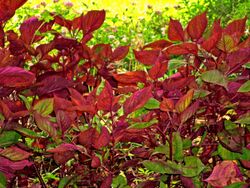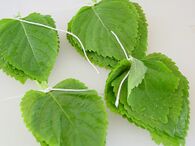Biology:Perilla
| Perilla | |
|---|---|

| |
| Perilla frutescens | |
| Scientific classification | |
| Kingdom: | Plantae |
| Clade: | Tracheophytes |
| Clade: | Angiosperms |
| Clade: | Eudicots |
| Clade: | Asterids |
| Order: | Lamiales |
| Family: | Lamiaceae |
| Subfamily: | Nepetoideae |
| Tribe: | Elsholtzieae |
| Genus: | Perilla L. |
Perilla is a genus consisting of one major Asiatic crop species Perilla frutescens and a few wild species in nature belonging to the mint family, Lamiaceae. The genus encompasses several distinct varieties of Asian herb, seed, and vegetable crop, including P. frutescens (deulkkae) and P. frutescens var. crispa (shiso).[1] The genus name Perilla is also a frequently employed common name ("perilla"), applicable to all varieties.[2][3] Perilla varieties are cross-fertile and intra-specific hybridization occurs naturally.[1] Some varieties are considered invasive.[4]
Taxa and synonyms
The classification of Perilla is confused, partly because botanists struggled with distinguishing the two distinct cultigens as different species or variations.[1][5] Until a few decades ago, P. frutescens var. crispa was regarded as a species in its own right, distinct from P. frutescens, although it was well established that these types readily cross-pollinate.[6] An early example of dividing the two cultigens into different species is found in Matsumura's 1884 nomenclature book, where the synonym P. arguta Benth. is applied to P. frutescens var. crispa, and the synonym P. ocymoides L. was applied to P. frutescens.[7][8][9][10] The species name P. ocymoides or P. ocimoides has historically been used to denote P. frutescens var. crispa, especially by the Japanese,[lower-alpha 1][6] therefore it should not be considered an interchangeable synonym for either cultigen. Recent genetic research confirms that the cultigens are of a common gene pool, corroborating the taxonomists' claim for consolidating the two crops into one species.[11]
Existing Perilla species:
- P. frutescens – also called Korean perilla or deulkkae; the leaves are called kkaennip
- P. f. var. crispa – also called shiso, tía tô, or Japanese basil[12]
- P. f. var. hirtella – also called lemon perilla[13]
Possible Perilla species with insufficient description and without known herbarium specimens include:
- P. cavaleriei H.Lév.
- P. heteromorpha Carrière
- P. setoyensis G.Honda
The past legacies and subsequent reclassification of taxa has led to confusion of nomenclature.[14][5] The red or purple leafed variety of P. frutescens var. crispa had been dubbed P. nankinensis,[5] and this label was used throughout the 19th century in the West following the introduction of the species for ornamental planting. Whether green-leafed or red-leafed, the perillaldehyde factor that characterizes the unique P. frutescens var. crispa fragrance may turn out to be present or absent in the individual or population, and this is not differentiable from outward appearance alone. Chemical studies classify the genus into different chemotypes, depending on the essential oils they contain. Three wild species that are endemic to Japan are recognized as genetically distinct from the cultivated P. frutescens var. crispa,[11] however, some references treat, e.g., P. frutescens var. hirtella as the same species as the P. frutescens var. crispa.[10]
Formerly placed here
- P. elata D.Don. = Elsholtzia blanda (Benth.) Benth.[15]
- P. fruticosa D.Don = Elsholtzia fruticosa (D. Don) Rehder[15][16]
- P. lanceolata Benth = Mosla scabra (Thunb.) C.Y.Wu & H.W.Li
- P. leptostachya D.Don. = Elsholtzia stachyodes (Link) Raizada & H.O.Saxena[15][17]
- P. marathrosma Spreng. = Agastache foeniculum (Pursh) Kuntze
- P. nankinensis Wender. = Plectranthus scutellarioides (L.) R.Br.
- P. polystachya D.Don. = Elsholtzia ciliata (Thunb.) Hyl.[15]
Use
Culinary use
Perilla varieties are cultivated and consumed mainly in Korea, Japan , Thailand and Vietnam.[18] P. frutescens leaves, seeds, and seed oil are used extensively in Korean cuisine, while P. frutescens var. crispa leaves, seeds, and sprouts are used in Japanese and Vietnamese cuisines.[19]
Herbalism
Perilla is one of the 50 fundamental herbs in Traditional Chinese Medicine. It is called "zi su" (紫苏/紫蘇), and is used to disperse wind-cold, bloating, and stomach and lung problems. It is sometimes paired with Tu Huo Xiang or Guang Huo Xiang to dispel dampness and tonify qi.
Notes
- ↑ e.g. occurs in Heibonsha 1964 Encyclopedia, though the genus name is misspelt
References
- ↑ 1.0 1.1 1.2 Nitta, Miyuki; Lee, Ju Kyong; Ohnishi, Ohmi (2003). "AsianPerilla crops and their weedy forms: Their cultivation, utilization and genetic relationships". Economic Botany 57 (2): 245–253. doi:10.1663/0013-0001(2003)057[0245:APCATW2.0.CO;2]. ISSN 0013-0001.
- ↑ Vaughan, John; Geissler, Catherine (2009). The New Oxford Book of Food Plants (2nd ed.). Oxford: Oxford University Press. pp. 340. ISBN 9780199549467. https://books.google.com/books?id=2g99Q6-RSdAC&pg=PT340.
- ↑ Staples, George W.; Kristiansen, Michael S. (1999). Ethnic Culinary Herbs: A Guide to Identification and Cultivation in Hawaiʻi. Honolulu: University of Hawaiʻi Press. pp. 82. ISBN 9780824820947. https://books.google.com/books?id=jbsdYHEJiDIC&pg=PA82.
- ↑ "Beefsteak Plant (Perilla frustescens)". U. S. Department of the Interior. 11 November 2010. https://www.nps.gov/plants/ALIEn/pubs/midatlantic/pefr.htm.
- ↑ 5.0 5.1 5.2 Yu, He-ci, ed (1997). Perilla: The Genus Perilla. London: CRC Press. pp. 1–3. ISBN 9789057021718. https://books.google.com/books?id=M5A71gsWUskC&pg=PA1.
- ↑ 6.0 6.1 Satake, Yoshisuke, ed (1969). "shiso". Sekai dai-hyakka jiten. 10. Tōkyō: Heibonsha. pp. 246–207.
- ↑ Matsumura, Jinzō (1884). Nippon shokubutsumeii. Tōkyō: Z.P. Maruya. pp. 136. https://archive.org/details/b30093077.
- ↑ Roecklein, John C., ed (1987) (in en). A Profile of Economic Plants. New Brunswick, U.S.A: Transaction Publishers. pp. 349. ISBN 9780887381676. https://books.google.com/books?id=C8eRalwPua0C&pg=PA349.
- ↑ Kays, S. J. (2011). Cultivated Vegetables of the World:: A Multilingual Onomasticon. Wageningen: Wageningen Academic Publishers. pp. 180–181, 677–678. ISBN 9789086861644. https://books.google.com/books?id=9c7LggdxjBcC&pg=PA677.
- ↑ 10.0 10.1 Blaschek, Wolfgang, ed (1998) (in de). Hagers Handbuch der Pharmazeutischen Praxis (3 ed.). Berlin: Gabler Wissenschaftsverlage. pp. 328–. ISBN 9783540616191. https://books.google.com/books?id=XGXnVRiu3zoC&pg=PA328.
- ↑ 11.0 11.1 Ito, Michiho (2008). "Studies on Perilla Relating to Its Essential Oil and Taxonomy". in Matsumoto, Takumi. Phytochemistry Research Progress. New York: Nova Biomedical Books. pp. 13–30. ISBN 9781604562323. https://books.google.com/books?id=l5Mo0M5CqQcC&pg=PA13.
- ↑ Mendelson, Charlotte (29 Jul 2017). "The Garden's Tiny Culinary Transformations". The New Yorker. https://www.newyorker.com/culture/onward-and-upward-in-the-garden/the-gardens-tiny-culinary-transformations. Retrieved 18 Nov 2017.
- ↑ Seidemann, Johannes (2005). World Spice Plants: Economic Usage, Botany, Taxonomy. Berlin: Springer. pp. 278. ISBN 9783540222798. https://books.google.com/books?id=jjkAHi2IeOkC&pg=PA278.
- ↑ Zeevaart, Jan A. D. (1969). "Perilla". in Evans, L. T.. The Induction of Flowering: Some Case Histories. Ithaca, NY: Cornell University Press. pp. 116–155. ISBN 9780333101537. https://books.google.com/books?id=9rw9AAAAIAAJ.
- ↑ 15.0 15.1 15.2 15.3 Bentham, George (1836). Labiatarum Genera et Species. London: James Ridgway and Sons. pp. 166. https://books.google.com/books?id=uGhTAAAAYAAJ&pg=PA166.
- ↑ Wiersema, John H.; León, Blanca (1999). World Economic Plants: A Standard Reference. CRC Press. ISBN 9780849321191. http://www.ars-grin.gov/~sbmljw/introd.htm.
- ↑ Pangtey, Y. P. S.; Rawal, R. S. (1994). High altitudes of the Himalaya: Biodiversity, ecology & environment. Nainital, India: Gyanodaya Prakashan. pp. 338.
- ↑ Grbic, Nikolina; Pinker, Ina; Paschko, Kerstin; Böhme, Michael (18–21 September 2016). "The Nutritional Treasure of Leafy Vegetables-Perilla frutescens". in Freyer, Bernhard; Tielkes, Eric. Tropentag 2016 Wien: International Research on Food Security, Natural Resource Management and Rural Development. Göttingen, Germany: Cuvillier. p. 105. ISBN 978-3-9801686-7-0. http://www.tropentag.de/2016/proceedings/proceedings.pdf. Retrieved 5 May 2017.
- ↑ Brenner, David M. (1993). "Perilla: Botany, Uses and Genetic Resources". in J., Janick. New crops. New York: John Wiley & Sons. pp. 322–328. ISBN 978-0-471-59374-4. https://hort.purdue.edu/newcrop/proceedings1993/V2-322.html.
Wikidata ☰ Q7168518 entry
 |



